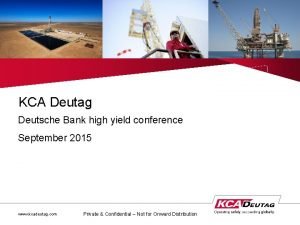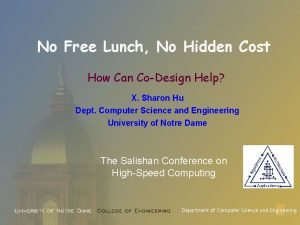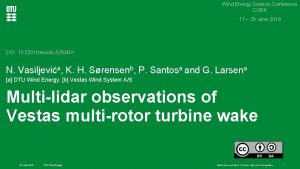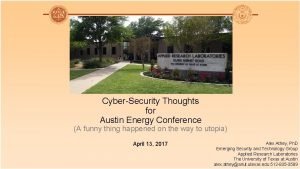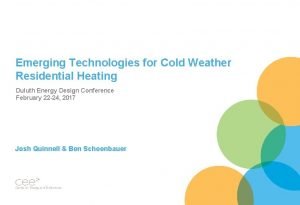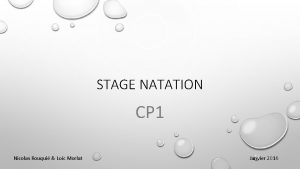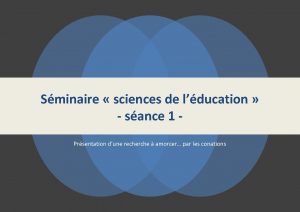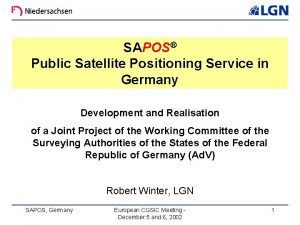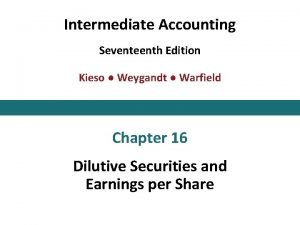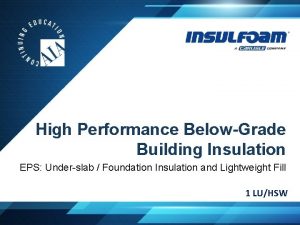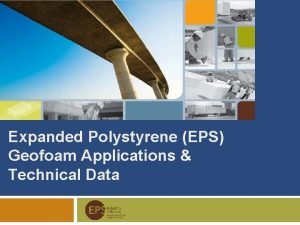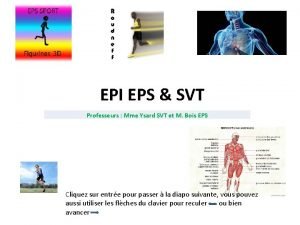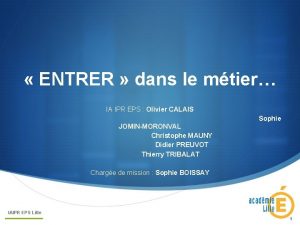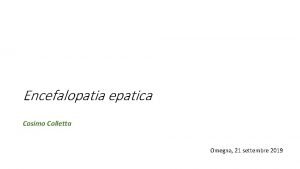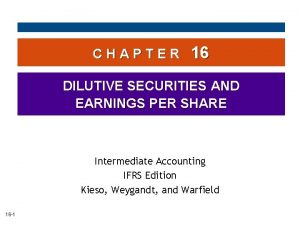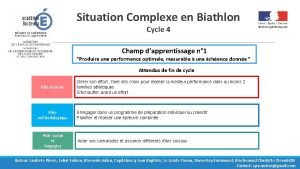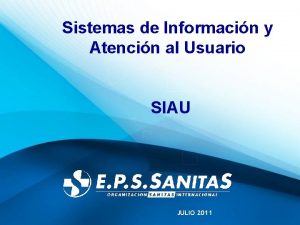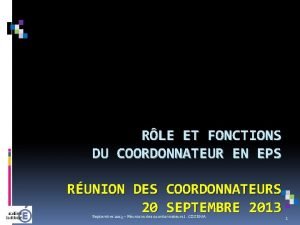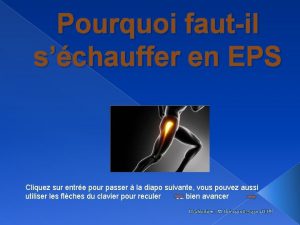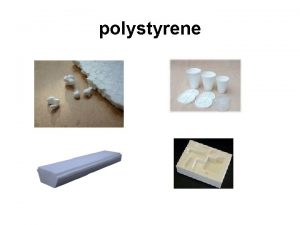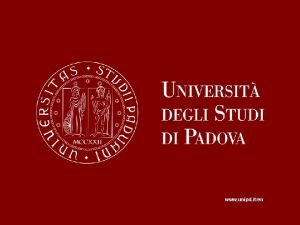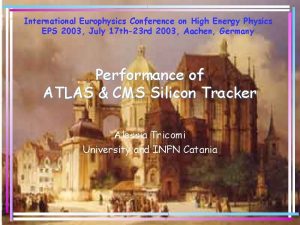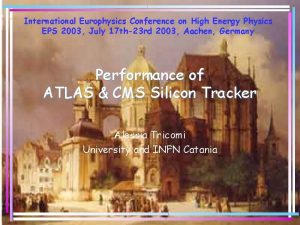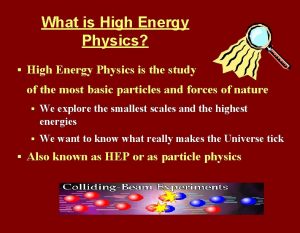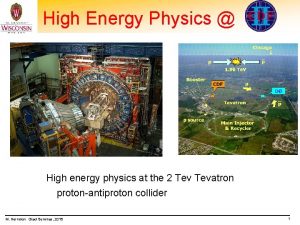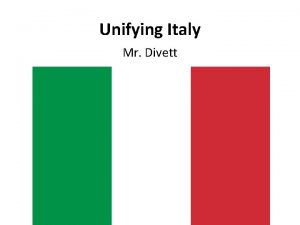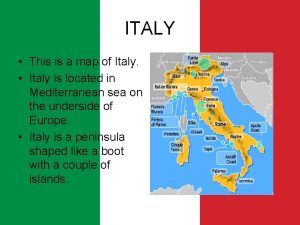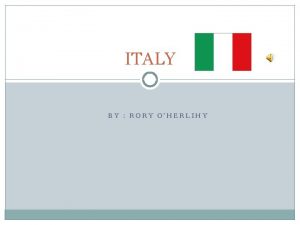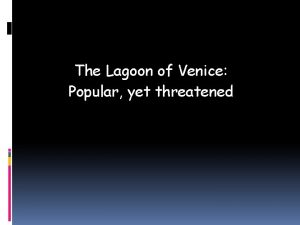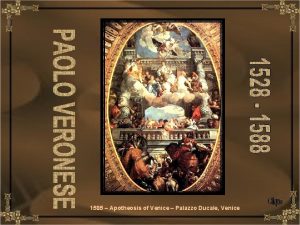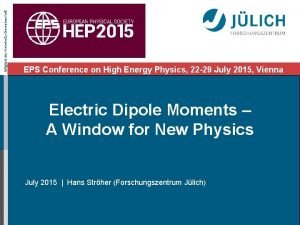EPS Conference on High Energy Physics Venice Italy

























![Systematic errors and exposure for ESSnu. SB systematic errors see 1209. 5973 [hep-ph] (lower Systematic errors and exposure for ESSnu. SB systematic errors see 1209. 5973 [hep-ph] (lower](https://slidetodoc.com/presentation_image_h/2739e58d7371a0cbad5b8d367b3b7426/image-26.jpg)





- Slides: 31

EPS Conference on High Energy Physics Venice, Italy 5 -12 July 2017 Neutrino CP Violation with the ESSνSB project Marcos Dracos on behalf of the ESSνSB group EPS 2017, July 2017 M. Dracos IPHC-IN 2 P 3/CNRS/UNISTRA 1

European Spallation Source under construction phase (~1. 85 B€ facility) EPS 2017, July 2017 M. Dracos IPHC-IN 2 P 3/CNRS/UNISTRA 2

ESS proton linac • The ESS will be a copious source of spallation neutrons. • 5 MW average beam power. • 125 MW peak power. • 14 Hz repetition rate (2. 86 ms pulse duration, 1015 protons). • Duty cycle 4%. • 2. 0 Ge. V protons (up to 3. 5 Ge. V with linac upgrades). • >2. 7 x 1023 p. o. t/year. Linac ready by 2023 (full power and energy) EPS 2017, July 2017 M. Dracos IPHC-IN 2 P 3/CNRS/UNISTRA 3

ESSνSB ν energy distribution neutrinos anti-neutrinos • almost pure νμ beam • small νe contamination which could be used to measure νe cross-sections in a near detector at 100 km from the target and per year (in absence of oscillations) EPS 2017, July 2017 M. Dracos IPHC-IN 2 P 3/CNRS/UNISTRA 4

CP Violating Observables (νμ→νe) atmospheric solar Non-CP terms interference CP violating ≠ 0 ⇒ CP Violation be careful, matter effects also create asymmetry EPS 2017, July 2017 M. Dracos IPHC-IN 2 P 3/CNRS/UNISTRA matter effect ⇒ accessibility to mass hierarchy ⇒ long baseline 5

δCP and matter-antimatter asymmetry magnitude (Jarlskog invariant) Theoretical models predict that if |sinδCP|≳ 0. 7 (45°<δCP<135° or 225°<δCP<315°), it could be enough to explain the observed asymmetry. EPS 2017, July 2017 M. Dracos IPHC-IN 2 P 3/CNRS/UNISTRA 6

Neutrino Oscillations with "large" θ 13=1º ("small" θ 13) θ 13=8. 8º solar atmospheric solar L/E CP interference • for small θ 13 1 st oscillation maximum is better (ar. Xiv: 1110. 4583) • for "large" θ 13 1 st oscillation maximum is dominated by atmospheric term • 1 st oscillation max. : A=0. 3 sinδCP • 2 nd oscillation max. : A=0. 75 sinδCP EPS 2017, July 2017 ("large" θ 13) atmospheric L/E CP interference 2 nd oscillation maximum d. CP=-90 d. CP=+90 θ 13=8. 8º ("large" θ 13) L/E more sensitivity at 2 nd oscillation max. (see ar. Xiv: 1310. 5992 and ar. Xiv: 0710. 0554) M. Dracos IPHC-IN 2 P 3/CNRS/UNISTRA 7

Can we go to the 2 nd oscillation maximum using our proton beam? Yes, if we place our far detector at around 500 km from the neutrino source. MEMPHYS like Cherenkov detector (MEgaton Mass PHYSics studied by LAGUNA) • • (ar. Xiv: hep-ex/0607026) Neutrino Oscillations (Super Beam, Beta Beam) Proton decay Astroparticles Understand the gravitational collapsing: galactic SN ν Supernovae "relics" Solar Neutrinos Atmospheric Neutrinos • 500 kt fiducial volume (~20 x. Super. K) • Readout: ~240 k 8” PMTs • 30% optical coverage EPS 2017, July 2017 M. Dracos IPHC-IN 2 P 3/CNRS/UNISTRA 8

2 nd Oscillation max. coverage detected (electron) neutrinos by MEMPHYS detector 1 st oscillation max. 2 nd oscillation max. well covered by the ESS neutrino spectrum EPS 2017, July 2017 M. Dracos IPHC-IN 2 P 3/CNRS/UNISTRA 9

ESS Linac modifications to produce a neutrino Super Beam ina ro u E n a e p EPS 2017, July 2017 L e rc u o S on i t lla a Sp c M. Dracos IPHC-IN 2 P 3/CNRS/UNISTRA 10

How to add a neutrino facility? • The neutron program must not be affected and if possible synergetic modifications. • Linac modifications: double the rate (14 Hz → 28 Hz), from 4% duty cycle to 8%. • Accumulator (C~400 m) needed to compress to few μs the 2. 86 ms proton pulses, affordable by the magnetic horn (350 k. A, power consumption, Joule effect) • H- source (instead of protons), • Target station (studied in EUROν). • Underground detector (studied in LAGUNA). • Short pulses (~μs) will also allow DAR experiments (as those proposed for SNS) using the neutron target. EPS 2017, July 2017 M. Dracos IPHC-IN 2 P 3/CNRS/UNISTRA 11

Mitigation of high power effects (4 -Target/Horn system for EUROnu Super Beam) Packed bed canister in symmetrical transverse flow configuration (titanium alloy spheres) Helium Flow 4 -target/horn system to mitigate the high proton beam power (4 MW) and rate (50 Hz) target inside the horn 8 m concrete Split Proton Beam Dump Neutrino Beam Direction Collimators EPS 2017, July 2017 Horns and Targets Decay Volume (He, 4 x 4 x 25 m 3) M. Dracos IPHC-IN 2 P 3/CNRS/UNISTRA 12

Physics Performance • little dependence on mass hierarchy (not so long baseline), • δCP coverage at 5 σ C. L. up to 60%, • δCP accuracy down to 6° at 0° and 180° (absence of CPV for these two values), • not yet optimized facility. EPS 2017, July 2017 M. Dracos IPHC-IN 2 P 3/CNRS/UNISTRA 13

Which baseline? Garpenberg Zinkgruvan CPV (Nucl. Phys. B 885 (2014) 127) • ~60% δCP coverage at 5 σ C. L. • >75% δCP coverage at 3 σ C. L. • systematic errors: 5%/10% (signal/backg. ) EPS 2017, July 2017 Garpenberg mine (1230 m) M. Dracos IPHC-IN 2 P 3/CNRS/UNISTRA 14

Muons at the level of the beam dump 2. 7 x 1023 p. o. t/year y (cm) muons at the level of the beam dump (per proton) x (cm) 10 -3 (16. 3 x 1020 for 4 m 2) 4. 1 x 1020 μ/year x (cm) muons/proton <Eμ>~0. 46 Ge. V <Lμ>~2. 9 km EPS 2017, July 2017 4. 2 x 1020 μ/year • input beam for future 6 D m cooling experiments (for muon collider), • good to measure neutrino x-sections (νμ, νe) around 200 -300 Me. V using a near detector, • low energy nu. STORM, • Neutrino Factory, • Muon Collider. M. Dracos IPHC-IN 2 P 3/CNRS/UNISTRA 15

ESS neutrino and muon facility 2. 7 x 1023 p. o. t/year Neutrons to ESS proton driver Protons dump p decay Accumulator m+ or m- Muons of average energy ~0. 5 Ge. V at the level of the beam dump (per proton) Front end nm or nm m Test Facility m Decay channel or ring Long Baseline Detector nm + ne ne + nm Storage ring RLA acceleration Cooling RCS acceleration Collider ring ESSnu. SB Short Baseline Detector Short nu. STORM Baseline Long Baseline Detector Neutrino Factory Muon Collider → ← μ+ μmore than 4 x 1020 μ/year from ESS compared to 1014 μ used by all experiments up to now (1018 μ for COMET in the future). EPS 2017, July 2017 M. Dracos IPHC-IN 2 P 3/CNRS/UNISTRA 16

ESSνSB at the European level • COST application for networking has been succeeded: CA 15139 (2016 -2019) • Euro. Nu. Net : Combining forces for a novel European facility for neutrinoantineutrino symmetry violation discovery (http: //www. cost. eu/COST_Actions/ca/CA 15139) • Major goals of Euro. Nu. Net: • to aggregate the community of neutrino physics in Europe to study the ESSνSB concept in a spirit of inclusiveness, • to impact the priority list of High Energy Physics policy makers and of funding agencies to this new approach to the experimental discovery of leptonic CP violation. • 13 participating countries (network still growing). EPS 2017, July 2017 M. Dracos IPHC-IN 2 P 3/CNRS/UNISTRA 17

ESSνSB at the European level • A H 2020 EU Design Study has been submitted end of March (Call INFRADEV-01 -2017) • Title of Proposal: Discovery and measurement of leptonic CP violation using an intensive neutrino Super Beam generated with the exceptionally powerful ESS linear accelerator • Duration: 4 years EUROν (2008 -2012) • Total cost: 4. 7 M€ LAGUNA (2008 -2010) LAGUNALBNO (20102014) ISS (20052007) • Requested budget: 3 M€ • 15 participating institutes from 11 European countries including CERN and ESS BENE (20042008) ESSνSB COST Action CA 15139 (2015 -2019) • 6 Work Packages • Decision before end of August EPS 2017, July 2017 M. Dracos IPHC-IN 2 P 3/CNRS/UNISTRA 18

Possible Schedule for ESSνSB • COST CA 15139: 2016 -2019 • EU H 2020 Design Study: 2018 -2021 • Decision for ESSνSB: 2022 • End of Linac construction: 2023 • Construction of ESSνSB: 2023 -2030 • Data taking: 2030 -2040 (for CPV). • Rich muon program after. EPS 2017, July 2017 M. Dracos IPHC-IN 2 P 3/CNRS/UNISTRA 19

Conclusion • Significantly better CPV sensitivity at the 2 nd oscillation maximum. • The European Spallation Source Linac will be ready in less than 10 years (5 MW, 2 Ge. V proton beam by 2023). • ESS will have enough protons to go to the 2 nd oscillation maximum and increase its CPV sensitivity. • CPV: 5 σ could be reached over 60% of δCP range (ESSνSB) with large potentiality. • Large associated detectors have a rich astroparticle physics program. • Rich muon program. • A Design Study is needed. • COST network project CA 15139 already supports this project. EPS 2017, July 2017 M. Dracos IPHC-IN 2 P 3/CNRS/UNISTRA 20

Backup EPS 2017, July 2017 M. Dracos IPHC-IN 2 P 3/CNRS/UNISTRA 21

Neutrino spectra 540 km (2 Ge. V), 10 years neutrinos below ντ production, almost only QE events anti-neutrinos δCP=0 2 years EPS 2017, July 2017 M. Dracos IPHC-IN 2 P 3/CNRS/UNISTRA 8 years 22

ESS under construction ν p n May 2017 EPS 2017, July 2017 H- M. Dracos IPHC-IN 2 P 3/CNRS/UNISTRA 23

ESS under construction September 2014 Cryo Compressor Building EPS 2017, July 2017 Beam Line Gallery M. Dracos IPHC-IN 2 P 3/CNRS/UNISTRA monolith and active cells 24

Preparing the ESS linac for operation at 10 MW with a 8% duty cycle and 28 Hz pulsing For the medium-beta elliptical-cavity part ESS is planning to use tetrodes. Thales has developed a new screen grid with graded wire thickness making operation at 10 % duty cycle possible. The picture shows the cryostat and test bunker at the FREIA Lab in Uppsala where a first prototype of the ESS 352 MHz spoke accelerating cavity is currently under test at 14 Hz and later on will be tested at 28 Hz. FREIA Lab, Uppsala EPS 2017, July 2017 M. Dracos IPHC-IN 2 P 3/CNRS/UNISTRA 25
![Systematic errors and exposure for ESSnu SB systematic errors see 1209 5973 hepph lower Systematic errors and exposure for ESSnu. SB systematic errors see 1209. 5973 [hep-ph] (lower](https://slidetodoc.com/presentation_image_h/2739e58d7371a0cbad5b8d367b3b7426/image-26.jpg)
Systematic errors and exposure for ESSnu. SB systematic errors see 1209. 5973 [hep-ph] (lower limit "default" case, upper limit "optimistic" case) P 5 requirement: 75% at 3 σ 20 years 10 years High potentiality (courtesy P. Coloma) EPS 2017, July 2017 M. Dracos IPHC-IN 2 P 3/CNRS/UNISTRA 26

δCP accuracy performance (USA snowmass process, P. Coloma) "default" column for systematic errors see (7. 5%/15% for ESSnu. SB): • Phys. Rev. D 87 (2013) 3, 033004 [ar. Xiv: 1209. 5973 [hep-ph]] • ar. Xiv: 1310. 4340 [hep-ex] Neutrino "snowmass" group conclusions EPS 2017, July 2017 M. Dracos IPHC-IN 2 P 3/CNRS/UNISTRA 27

Comparisons EPS 2017, July 2017 M. Dracos IPHC-IN 2 P 3/CNRS/UNISTRA 28

δCP coverage CPV (2 Ge. V protons) "nominal" after 10 years x 2 with 2 times more statistics systematic errors (nominal values): 5%/10% for signal/background more than 50% δCP coverage using reasonable assumptions on systematic errors EPS 2017, July 2017 M. Dracos IPHC-IN 2 P 3/CNRS/UNISTRA 29

The MEMPHYS Detector (Proton decay) (ar. Xiv: hep-ex/0607026) EPS 2017, July 2017 M. Dracos IPHC-IN 2 P 3/CNRS/UNISTRA 30

The MEMPHYS Detector SUPERK MEMPHYS (Supernova explosion) For 10 kpc: ~105 events EPS 2017, July 2017 Diffuse Supernova Neutrinos (10 years, 440 kt) M. Dracos IPHC-IN 2 P 3/CNRS/UNISTRA 31
 Venice italy geography
Venice italy geography Energy energy transfer and general energy analysis
Energy energy transfer and general energy analysis Energy energy transfer and general energy analysis
Energy energy transfer and general energy analysis Kca investor relations
Kca investor relations Salishan conference on high speed computing
Salishan conference on high speed computing Modern physics vs classical physics
Modern physics vs classical physics University physics with modern physics fifteenth edition
University physics with modern physics fifteenth edition Physics ia exemplars
Physics ia exemplars Wind energy science conference 2019
Wind energy science conference 2019 Austin cybersecurity conference
Austin cybersecurity conference Duluth energy design conference
Duluth energy design conference Nicolas rouquie eps
Nicolas rouquie eps Curriculum conatif eps
Curriculum conatif eps Ex rights price
Ex rights price Sapos
Sapos Ipack eps paris
Ipack eps paris G-eps
G-eps Annual eps growth
Annual eps growth Basic and diluted eps formula
Basic and diluted eps formula Below grade eps
Below grade eps Geofoam applications
Geofoam applications Merci pour votre attention svt
Merci pour votre attention svt Eps olivier
Eps olivier Laevolac eps per diabetici
Laevolac eps per diabetici Digital token based electronic payment system
Digital token based electronic payment system Course de haies cycle 4
Course de haies cycle 4 Dilutive securities
Dilutive securities Biathlon eps cycle 4
Biathlon eps cycle 4 Quejas eps sanitas
Quejas eps sanitas Coordonnateur eps
Coordonnateur eps Pourquoi s'échauffer en eps
Pourquoi s'échauffer en eps Eps foam pro
Eps foam pro



